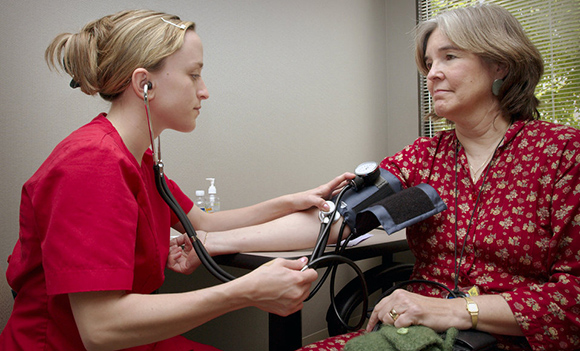
(Photo: Public Health Image Library)
In his State of the State address, Governor Gavin Newsom committed to taking on a host of critical issues this year, none bigger than expanding access to health care—one of the most ambitious elements of his January budget proposal (and, not coincidentally, one of the greatest sources of anxiety for millions of Californians).
While the governor has talked before about extending coverage and bringing down drug prices, he introduced another element of his health strategy for the first time this week: the need to close looming shortfalls of workers in key health sectors—especially caretakers for Medi-Cal recipients and the state's growing numbers of retiring Baby Boomers. To take on these challenges, Newsom proposed more funding through the budget, an updated “Master Plan on Aging,” and a new Commission on California’s Workforce & Future of Work—with a broad mandate to develop solutions that ensure workers can get the training they need to access well-paying jobs.
All of this sounds exactly right—and as with so many other elements of the governor’s agenda, it is entirely consistent with the priorities of CA Fwd and its partners in the California Economic Summit.
It’s worth noting, though, that if the governor wants to expand access to health care and create more skilled workers all over the state—top priorities in every region involved in the Summit—there may actually be ways to do both at the same time.
Last week, a group called the California Future Health Workforce Commission released a comprehensive, 184-page plan for tackling these same issues—with proposals that would completely eliminate a projected shortfall of more than 4,100 primary care clinicians over the next 10 years, nearly eliminate the state’s growing shortage of mental health professionals, and make significant progress in closing an expected gap of 600,000 home care workers.
The total cost of these recommendations is $3 billion over the next decade, with new investments focused on expanding pipeline programs, providing scholarships and financial aid to bring underserved populations into the health delivery system, and creating new career ladders and practice opportunities for home health workers and nurses.
If all of this sounds simple, it’s not. Finding funding for such a comprehensive strategy is never easy (though its annual $300 million cost would be about the same as the state's successful Strong Workforce Program), and political obstacles are already looming. But there is no doubt this group understands the scale—and potential—of this undertaking. The Commission, which included 24 experts from the fields of health, policy, workforce development, and education, spent more than a year studying California’s health workforce challenge and working with stakeholders to develop a set of solutions that would match the scale of the problem. The effort was co-chaired by leaders who are well positioned to advance these ideas: Janet Napolitano, president of the University of California, and Lloyd Dean, president and CEO of Dignity Health, one of the state’s largest health systems and health employers.
The Commission’s recommendations also align closely with work already underway across the workforce development system—including the Summit's partners in the state's 114 community colleges, which are adapting quickly to meet growing health sector demands. “To meet the workforce needs of California's largest and critical sector—health care—the community colleges are expanding and exploring new programs. Whether it's a direct patient care need like nursing, or imaging and diagnostics, or healthcare facility support, we have programs to address those needs,” said John Cordova, health sector navigator for the California Community Colleges, whose chancellor, Eloy Ortiz Oakley, served on the Commission. “Employers have needs for both upskilling current workers and finding new workers for this expanding sector. At the community colleges, we are part of the solution.”
As large and complex as California's health system is, the Health Workforce Commission and its partners recognize that the systems's very scale presents one of the best opportunities the new governor has to make an immediate impact on the issues he cares about: improving access to health care, while producing tens of thousands of skilled workers all over the state. The fact is, the health care industry represents almost 12.6 percent of the state’s economy, employing 1.4 million professionals across dozens of fields—numbers that will have to keep climbing as the state’s population grows and ages. The Los Angeles region alone is expected to have 125,000 job openings in health care fields over the next five years—jobs that provide more economic security than other occupations. The median wage for health care workers in 2017 was close to $65,000, compared to less than $38,000 for all occupations.
Given the sheer size of the health system, any progress made to improve health delivery and close gaps in care will not only improve health outcomes for millions of Californians—it will also put a substantial dent in the state’s skilled workforce challenge.
These issues have long been priorities for the Summit—and they are clearly at the top of the governor’s agenda, as well. If he is looking for ways to make an immediate impact—on both fronts—the California Future Health Workforce Commission has offered a good place to start.

